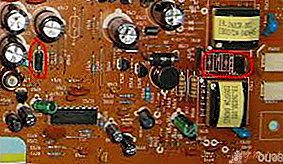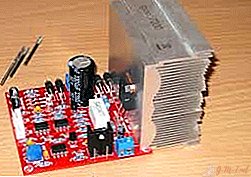 It happens that the image on the TV jerks, completely interfering with the correct perception of the frames displayed on the screen. There may be several reasons for this, and in this article we will consider the most common of them, and also suggest solutions.
It happens that the image on the TV jerks, completely interfering with the correct perception of the frames displayed on the screen. There may be several reasons for this, and in this article we will consider the most common of them, and also suggest solutions.
3 main reasons why the image on the TV jerks
No. 1 The problem is in the personnel development unit and the ways to resolve it.
The frame scan unit is one of the most important parts of televisions of both the old and newer models. We begin the test with a thorough inspection of all the details of the unit.
Important! When inspecting the microcircuit, make sure that there are no charred parts or burnt holes on it.
- Carefully consider noise suppressing capacitors, which, when they fail, swell a little and increase in size. If everything is normal with their chips, then look at the power circuits.
- Checking the busbar power supply of electronic components for operability consists in the use of a tester that determines whether or not current is supplied to all direct parts of the television power supply.
 In the case when the tester does not pay attention to the "power supply busbars of electronic components", it is necessary to check for gaps in them. To do this, you need to check each section of the chain separately. For example, if the path of the chain is really damaged, you need to check the damaged part of the chain and correct it with a soldering iron. But if the circuit resistance burns out, then it simply needs to be replaced with a new one.
In the case when the tester does not pay attention to the "power supply busbars of electronic components", it is necessary to check for gaps in them. To do this, you need to check each section of the chain separately. For example, if the path of the chain is really damaged, you need to check the damaged part of the chain and correct it with a soldering iron. But if the circuit resistance burns out, then it simply needs to be replaced with a new one.- Checking the personnel sweep must start with measuring the voltage, some are taken from the coil winding horizontal transformer.
- First of all, the resistor through which the power is supplied should be checked for operability. Although, before this, it is worth considering that often the so-called frame scan rectifier can fail. Also, a frame scan itself may fail.
Less often, of course, the problem that entailed “pulling the image on the TV” is frame deflection coils. Moreover, if this happens, then you need to replace these coils - there are simply no other solutions.
No. 2 The problem is in the line scan unit and methods of solving it.
When the horizontal scan comes into disrepair, the normalized voltage stops coming to the television picture tube. It is easy enough to verify this, even without special skills in this matter: if you bring your hand to the screen, hair will stand on end on it. If this does not happen, then diagnostics will be required.

Another equally important reason that the unit responsible for displaying the image does not work is because of damaged circuits that disconnect for the urgent system. They appear due to poor contact, poor soldering of contacts. Sometimes the fault for all this is the malfunction of the radio components.
No. 3 The problem of "image jitter" due to the power supply.
The power supply, briefly "BP" is used as a device for supplying voltage to all parts and microcircuits of the TV. Before you start any work with the PSU, you must disconnect the equipment from the network and discharge the noise suppressing capacitor.
 First of all, it is necessary to check in the power supply unit for a break: the power supply filter, the rectifier and the SHIP modulator.
First of all, it is necessary to check in the power supply unit for a break: the power supply filter, the rectifier and the SHIP modulator.- To begin with, a noise suppressing capacitor must have a stable voltage within three hundred watts. If it is absent, you need to check: are there any gaps in the surge protector.
- If there is a rated voltage of three hundred watts or more on the suppression capacitor, you will need to check the patency of the rated voltage to the key parts of the PS transistor.
- After checking the voltage, it is necessary to start checking the primary winding of the power transistor for an open.
If all of the above elemental parts are operational, and the PSU still does not turn on, then you will need to check the pulse current flow to the gate element of the television transistor. It is also necessary to check the trigger chains, usually they are resistors with high resistance.
Other reasons why the image on the TV screen may rattle
There are also factors due to the presence of which the TV screen may blink. For example, you can blame the antenna or a faulty socket for connecting the antenna cable.

Checking this is quite simple, you just need to connect the TV to a personal computer via an HDMI cable and turn it on, checking if there is any last ripple on the screen. You can also connect a TV to a DVD or VIDEO set-top box. If, after checking the picture, everything is in order and does not blink, nor does it ripple, then the problem is not in the technique.

 In the case when the tester does not pay attention to the "power supply busbars of electronic components", it is necessary to check for gaps in them. To do this, you need to check each section of the chain separately. For example, if the path of the chain is really damaged, you need to check the damaged part of the chain and correct it with a soldering iron. But if the circuit resistance burns out, then it simply needs to be replaced with a new one.
In the case when the tester does not pay attention to the "power supply busbars of electronic components", it is necessary to check for gaps in them. To do this, you need to check each section of the chain separately. For example, if the path of the chain is really damaged, you need to check the damaged part of the chain and correct it with a soldering iron. But if the circuit resistance burns out, then it simply needs to be replaced with a new one. First of all, it is necessary to check in the power supply unit for a break: the power supply filter, the rectifier and the SHIP modulator.
First of all, it is necessary to check in the power supply unit for a break: the power supply filter, the rectifier and the SHIP modulator.
Leave Your Comment